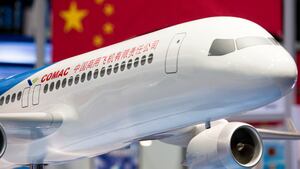It was 1964 and Gerhard Holtje was very angry with Boeing.
His title, managing director and chief engineer of the German national airline, Lufthansa, understated his importance. With vision and demanding technical skills he had played a key part in taking Lufthansa into the Jet Age and establishing it as a world class airline.
He did that with Boeing’s help. The two first commercial jets Boeing built, the intercontinental 707 and the shorter-range 727, delivered what he demanded of them.
But the new Boeing jet he had committed to buying was another story. In a way he was as much its creator as Boeing. He wanted a smaller jet able to carry between 100 and 130 passengers on inter-city routes throughout Europe, and he gave Boeing precise specifications that it should meet.
Other companies had pitched their new jets to him. The most appealing came from another American company, Douglas, a sleek little twinjet, the DC-9.
Holtje knew that Boeing desperately wanted to keep him from buying Douglas—for decades Douglas had been the nemesis of Boeing. In the age of propeller-powered airliners Douglas had held two-thirds of the world market.
Even though Boeing had blazed the trail into jets with brilliant innovations, Boeing engineers still remembered feeling underdogs to Douglas. Giving Holtje the new baby jet he outlined meant that they would be able offer other airlines a complete range of jets to fit the three sizes most in demand—and thereby more than match Douglas.
Holtje was way ahead of his time in another way. He wanted Boeing to make it easier for pilots to switch between types of jet with as little change in the cockpits as possible—a principle that became known as “fleet commonality.”
Boeing achieved that with the 707 and 727: the cockpits and most of the fuselage of those two jets were almost identical. Boeing agreed that the baby jet would follow suit. This had great economic appeal for Boeing because 64 per cent of the airplane’s components and 76 per cent of the cabin interior could be off-the shelf rather than new designs.
Within six months of Holtje describing the airplane he wanted, on March 15, 1965, a contract was signed in which Lufthansa would be the first customer for Boeing’s baby jet, buying 21 of them, designated as the Boeing 737.
The 737 made its first commercial flight as the Lufthansa City Jet on February 10, 1968. And it was a dog. Its performance fell so far short of what Holtje had specified that within a week of that first flight he summoned Boeing’s top salesman, E.H. “Tex” Boullioun, to Hamburg.
In a limited circulation internal Boeing memo written at the time and not previously disclosed, Bouillioun reported to the Boeing management that Holtje received him “with fire in his eyes. He was furious with Boeing. His anger wasn’t the kind of a man who is just mad—but the personal kind when someone feels he has been betrayed by a friend… he lectured bitterly and softly about how he’ll never trust Boeing again… he continues to get the same evasiveness and lies.”
Production line problems had caused delays in delivering the jets, but one thing that particularly inflamed Holtje was that a standard test applied to all new airplanes, a static test to test the strength of the wings, had resulted in the wing breaking before reaching the point of maximum permissible stress—a problem the engineers had fixed but without telling Holtje.
Only 30 of that first version of the 737 were built. A second version, ordered by United Airlines, benefited from extensive troubleshooting by Boeing engineers and improved engines. But it was not until a third version, launched in 1981, that the airplane conceived by Holtje finally delivered what had been originally promised.
Sales of future 737 models then exceeded anything that was thought possible in those first troubled years of its development—ultimately surpassing 10,000 and becoming a global phenomenon as budget airlines found it the perfect workhorse for intercity routes with high density demand, while Boeing had a gusher in terms of profits.
The origins of the 737 are particularly significant now, with Boeing engulfed in a world crisis of confidence with two crashes of the newest model, the 737 MAX-8, killing 346 people. Specifically, the origins of the design highlight the consequences to Boeing of believing that it could keep upgrading a 50-year-old design indefinitely.
Critically, decisions made by Boeing engineers to satisfy Holtje placed physical limits on how the technology of the digital age could be incorporated in an airframe of the analog age.
Holtje’s insistence on a commonality of cockpit design, for example, has meant that modern avionics like screens providing pilots with situational awareness and the behavior of vital systems have had to share cockpit space with older generational flight controls. Only one minor system of the MAX-8 uses “fly-by-wire” electronic controls while the remainder remain mechanically operated.
Even more pertinent are issues at the center of the investigation into the MAX-8 crashes. These involve the euphemistically named Maneuvering Characteristics Augmentation System, MCAS, which, when fed false data, was apparently capable of overriding pilot control and pushing the airplane into a fatal nose dive. But beyond the widely reported arcana of how and why this system’s flaws could have caused the two crashes is a simple question: why was it needed in the first place?
This is where the limits of the original design again have consequences. On the runway the 737 sits unusually close to the ground. That is because in the 1960s the jet would land at airports without equipment for mechanically unloading baggage and cargo. The 737’s cargo hold hatches were designed to be low enough for cargo to be loaded and unloaded by hand.
To achieve that the landing gear was shorter than on the bigger Boeing jets. However, as development of future 737 models progressed the engines became larger and, with the MAX series, came the largest of all. Had that engine been hung under the wing in the same way as on earlier models it would have been too close to the ground.
To achieve the necessary 17-inch clearance between the engine and tarmac the designers moved it forward and upward. Not only was the engine larger but it was more powerful. These changes altered what is called the basic “trim” of the airplane in flight—the aerodynamic balance of engine thrust and the flight controls.
During testing, both in a wind tunnel and on simulators, Boeing engineers realized that this change in trim could, under some flight conditions, critically influence the way the airplane handled under control of the pilots, introducing the risk of an aerodynamic stall.
That discovery led to the ill-fated introduction of MCAS, in software that took control from the pilots and intervened when it sensed that a stall was imminent.
It is important to understand that until the addition of MCAS to the airplane, none of the design compromises required to sustain the production of Boeing’s greatest cash cow had ever appeared to produce serious safety issues. But what they did produce was an airplane that was suboptimal, falling far short of the sophistication of the airplane that could have been produced had Boeing decided to replace the 737 with a clean-sheet design that fully reflected state-of-the-art engineering.
The moment to do that came in the early 1990s when, for the first time, Boeing realized that it had a competitor making serious inroads into the market for single-aisle jets, Airbus with its A320.
Boeing had seriously underestimated the threat posed by the A320. It was the first commercial jet to fully embrace fly-by-wire controls. Its cabin was wider than the 737’s and the basic A320 was capable of evolving into a larger, longer-range and more fuel-efficient version that would totally outclass the 737.
But it so happened that when Boeing finally woke up to the threat it was engaged in a deal that would transform its size and, equally its culture. In 1997 Boeing merged with McDonnell Douglas, an aerospace conglomerate that included the rump of Boeing’s old nemesis, Douglas.
Douglas had never matched Boeing in commercial jets. Its only long-running success was the small DC-9 and its later versions—the jet that Lufthansa had rejected in favor of the 737. Otherwise its big jets—the DC-10 and MD-11—were second-rate and never competitive with Boeing.
Nonetheless, to the chagrin of many Boeing engineers, it seemed that McDonnell Douglas had taken over Boeing, not the other way round, with top managers who were more alert to financial results and stock price. Looked at through this new discipline the capital costs of a new airplane to replace the 737, possibly as much as $15 billion, looked bad for the balance sheet.
On the other hand, a makeover could be achieved that would not involve anything like the same investment in research and new production lines. And so Boeing launched a hybrid, the 737 NG, New Generation, with new wings and avionics but retaining the original fuselage and many other features from earlier models.
The change in the whole corporate ethos of Boeing became more palpable in 2001 when the company moved corporate headquarters from Seattle to Chicago, confirming that in a business that combined aerospace and major defense contracts Seattle had become just another division, and commercial jets just another piece of the business, not the inspirational core of one of aviation’s greatest names.
When, a decade later, the question of replacing the 737 with a completely new model again came up the same decision was taken—the cheaper option of another upgrade, and thus was born the MAX. The airlines went for it because the new engines promised higher efficiency and—so it seemed—pilots would find it very simple to move from the NG to the MAX.
The decision to launch the MAX was taken by James McNerney, the company’s first boss without a background in aviation, with a résumé that included Procter & Gamble, McKinsey, General Electric and 3M. At GE McNerney was schooled under the hard-nosed bottom-line philosophy of Jack Welch.
When McNerney retired as chairman from Boeing at the age of 66 in 2016 he left with $35.8 million, part of it from selling stock but he still retained $238 million in stock and was awarded a pension of $3.2 million for 15 years. (Boeing production line workers had an annual bonus equivalent to nine days of pay.)
The days when a single generation of brilliant Boeing engineers doubled the speed at which airliners flew and created the world’s leading airplane company were long gone. It’s true that the costs of making that giant leap meant that Boeing was never a stellar stock market performer, and it took enormous risks. Launching the 747 jumbo nearly bankrupted the company. And Boeing executives were modestly rewarded compared to today’s corporate norms.
It was not a culture that McNerney thought admirable. He told financial analysts that running a company on the basis of “every 25 years a big moonshot, produce a 707 or a 787, that’s the wrong way to pursue this business. The more-for-less world will not let you produce moonshots.”
But the 737 MAX demonstrates that—regardless of whether you believe in moonshots - the engineering ethic at Boeing has yielded too much power to the profit motive. Saying that the 737 is suboptimal is too technically polite. It doesn’t describe the seriousness of the continual compromises made to avoid launching a new model. Boeing knew that the MAX could never match the quality of an all-new airplane.
Boeing had never taken that route with any airplane before; it was not part of the company’s tradition to knowingly settle for second-best.
As a result, the bitter irony is that no airplane has made more money for Boeing than the 737, and in the company’s 100-year history no airplane has so jeopardized the company’s reputation.








